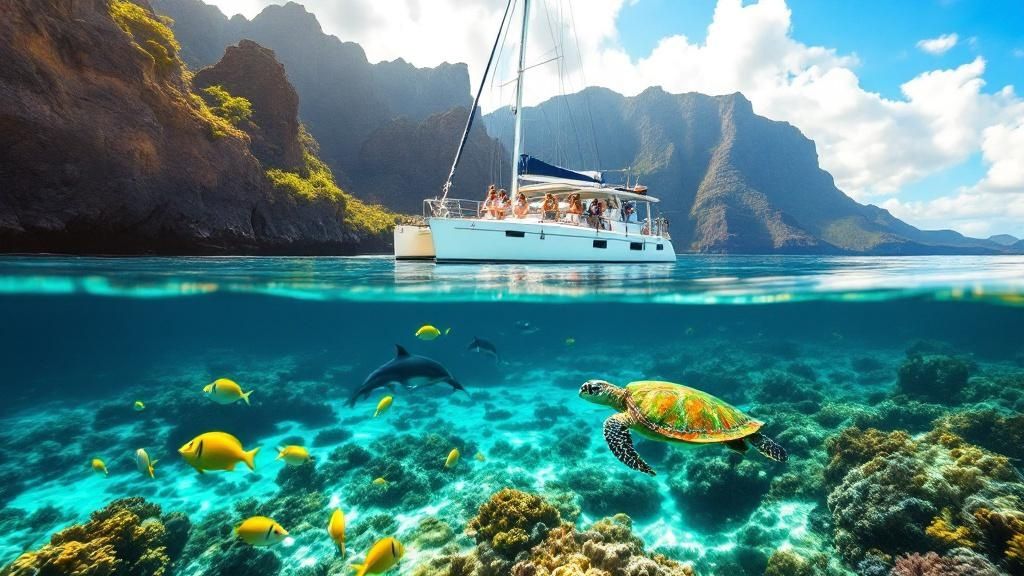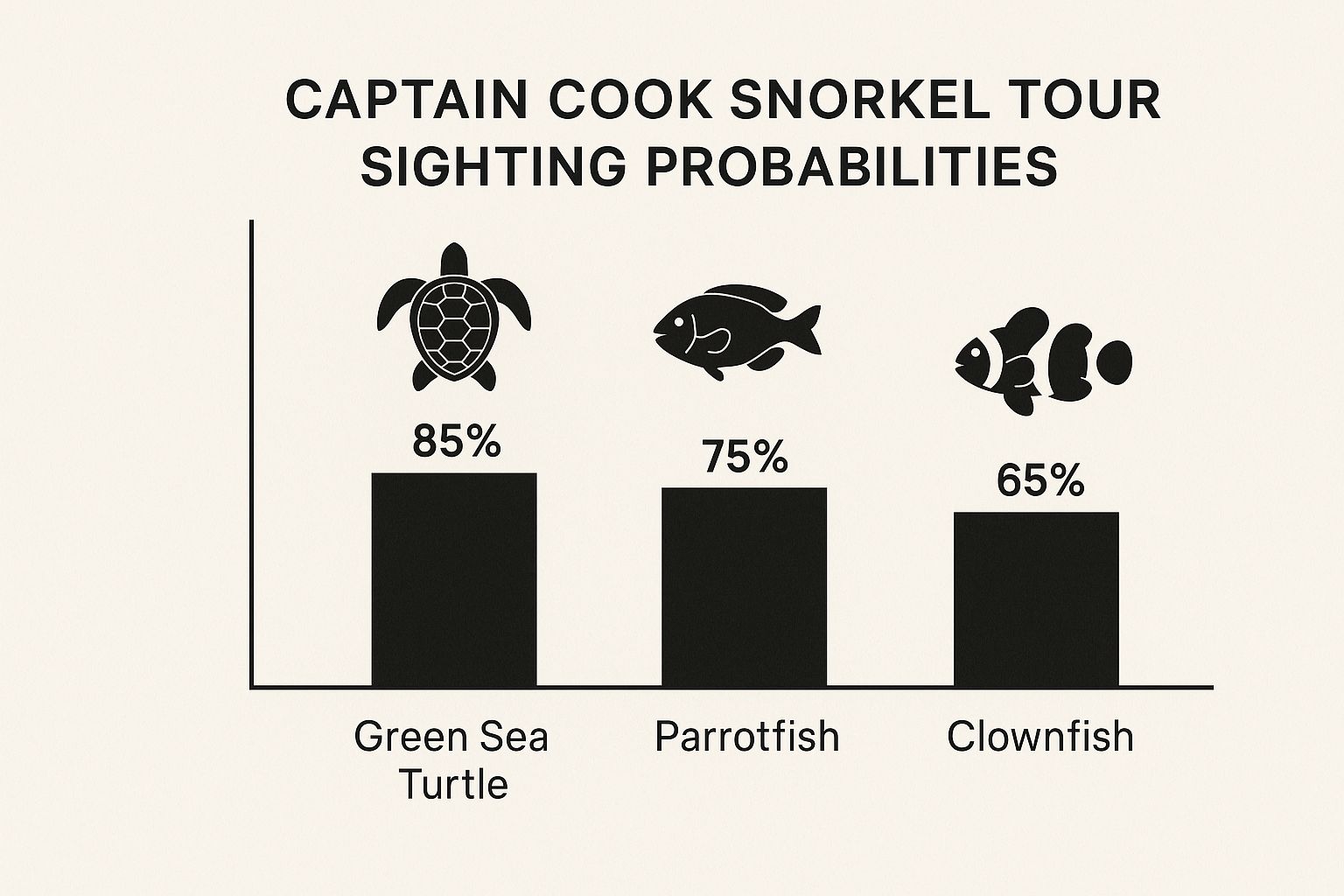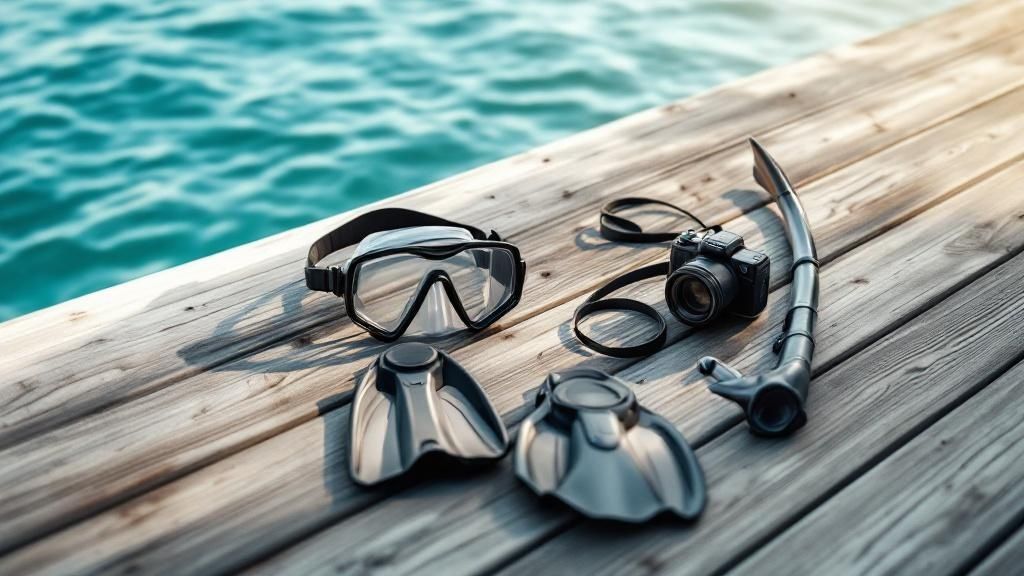Your Guide to the Captain Cook Snorkel Tour

A Captain Cook snorkel tour is one of those quintessential Big Island experiences you just have to do. It’s your ticket into the stunningly clear and protected waters of Kealakekua Bay, which is a designated Marine Life Conservation District. This isn't just about incredible snorkeling; it's a journey to a site steeped in Hawaiian history, making it as educational as it is breathtaking.
You're not just going for a swim. You're immersing yourself in a vibrant underwater world, floating above brilliant coral reefs absolutely packed with tropical fish.
Your Ultimate Kealakekua Bay Snorkeling Adventure

Picture this: you're floating effortlessly in calm, impossibly blue water, with dramatic volcanic cliffs rising all around you. That's the view from inside Kealakekua Bay. Even getting there is part of the magic. It’s not uncommon for pods of playful spinner dolphins to greet your boat, putting on a spectacular acrobatic show as they leap and twist in the morning sun.
This trip is far more than just another item on your vacation itinerary; it’s a deep dive into a sacred place that pulses with history and raw, natural beauty. Think of it as your front-row seat to an underwater spectacle, a chance to connect with an ecosystem that feels a million miles from the daily grind.
What Makes This Tour a Must-Do?
So, why is a Captain Cook snorkel tour so special? It's the unique combination of elements that elevates it from a simple boat trip to an unforgettable Big Island memory. Because the bay is a protected area, the marine life is off-the-charts abundant, and the water visibility is often second to none.
- Vibrant Marine Life: The bay is a thriving sanctuary for hundreds of species of fish, sprawling coral gardens, and often, the graceful Hawaiian green sea turtles, known as honu.
- Historical Significance: You’ll be snorkeling right near the Captain Cook Monument, which marks the historic spot where the British explorer Captain James Cook was killed in 1779.
- Pristine Conditions: As a Marine Life Conservation District, the bay’s waters are carefully managed, ensuring the reef system stays healthy for generations to come.
To give you a quick snapshot of what to expect, here’s a look at the key details of a typical tour.
Captain Cook Snorkel Tour At a Glance
| Feature | Typical Details |
|---|---|
| Tour Duration | 3-5 hours (morning tours are most common) |
| Activities Included | Guided snorkeling, historical narration, dolphin watching |
| Snorkel Spot | Ka`awaloa Cove, near the Captain Cook Monument |
| Meals/Snacks | Often includes tropical fruits, snacks, and drinks |
| Snorkel Gear | Usually provided (mask, snorkel, fins, floatation devices) |
| Historical Context | Narration about Captain Cook and ancient Hawaiian history |
| Price Range | $90 – $220 per person |
This table helps illustrate why the tour appeals to so many different people, from families looking for a fun day out to history buffs and dedicated snorkelers.
The bay’s popularity is no secret. Kealakekua Bay draws over 190,000 visitors each year, solidifying its role as a vital part of the island's ecotourism. With prices ranging from about $90 to $220, there’s a Captain Cook snorkel tour perfectly suited for just about anyone. That wide appeal is what makes it a world-class destination.
Discovering the History of Kealakekua Bay
Kealakekua Bay is a world-class snorkel spot, no doubt about it. But when you slip into those calm, clear waters, you're entering a place with a story that runs incredibly deep. Long before any ships from the West arrived, this bay was a major hub for Hawaiian life, politics, and religious ceremonies. Its name, Kealakekua, even translates to "the pathway of the god," likely honoring Lono, the god of peace, agriculture, and fertility.
This sacred setting became the backdrop for one of the most significant encounters in Hawaiian history. In January 1779, Captain James Cook sailed his ships into the bay. By a wild twist of fate, his arrival lined up perfectly with the Makahiki festival, a months-long celebration for Lono. Seeing the massive ships with their tall, white sails, many Hawaiians understandably wondered if this was Lono himself making a grand return.
A Fateful Encounter
At first, things went beautifully. The Hawaiians welcomed Cook and his men with incredible generosity, showering them with food and supplies for weeks. It was a fascinating, if fragile, period of cultural exchange, with each side trying to make sense of the other through their own unique lens.
But that peaceful harmony couldn't last. After sailing away, Cook's ship suffered a broken mast, forcing him to turn back to Kealakekua Bay for repairs. By then, the Makahiki festival was over. The godlike aura that had surrounded the British had vanished, and their unexpected return felt less like a divine visit and more like an unwelcome imposition.
The situation at Kealakekua Bay is a classic, tragic story of cultural miscommunication. What started as a peaceful exchange, built on a case of mistaken identity, fell apart as soon as the circumstances changed.
The Clash at Kaawaloa Cove
Tensions began to simmer and quickly boiled over. The breaking point came when a small cutter boat was stolen from one of Cook’s ships. On February 14, 1779, Cook went ashore at Kaawaloa Cove—the exact spot where you'll be snorkeling—and tried to take the high chief, Kalaniʻōpuʻu, hostage to guarantee the boat's return.
The plan was a disaster. A chaotic struggle broke out on the shoreline, and Captain Cook was killed. Today, the stark white obelisk you see from the water—the Captain Cook Monument—marks the approximate spot of that fateful event. It stands on a tiny piece of land that was deeded to the United Kingdom. For a closer look at what to expect right at the monument, check out our guide to snorkeling at the Captain Cook Monument.
Knowing this history completely changes how you experience your Captain Cook snorkel tour. When you're floating over that stunning reef, watching the colorful fish dart by, remember that you're in a living museum. This is a sacred place where two very different worlds collided, shifting the course of Hawaiian history forever. It makes the trip so much more than just a fun day on the water.
Exploring the Underwater World You Will See

While the history of Kealakekua Bay is incredible, the real main event on your Captain Cook snorkel tour starts the second your face mask hits the water. The bay is a designated Marine Life Conservation District, which basically acts as a permanent "do not disturb" sign for the ecosystem. Thanks to this protection, the reef has been allowed to thrive, becoming an unbelievably dense and vibrant underwater community.
The water clarity here is something you have to see to believe, often reaching an incredible 100 feet or more. It’s like peering through liquid glass into a bustling city, giving you a front-row seat to the daily lives of its colorful residents.
The Reef Fish You Are Likely To Meet
As soon as you slip into the water, you’ll be surrounded by schools of fish. It's the sheer diversity that really sets this place apart. You don’t just see a few fish here and there; you're immersed in a metropolis of fins, scales, and colors, with each creature playing its part in the reef’s intricate dance.
Here are just a few of the regulars you should keep an eye out for:
- Yellow Tang (Lauʻīpala): These bright, sunny-yellow fish are impossible to miss. They often cruise by in huge schools, creating a flash of brilliant color against the deep blue.
- Parrotfish (Uhu): If you listen carefully, you might hear a distinct crunch, crunch sound. That’s the parrotfish, doing its part by munching on algae-covered coral, which helps keep the reef clean and creates beautiful white sand in the process.
- Moorish Idol (Kihikihi): Easily one of the most elegant fish on the reef, the Moorish Idol is a photographer's dream with its trailing dorsal fin and bold black, white, and yellow stripes.
- Humuhumunukunukuāpuaʻa: Yes, it’s a mouthful! But you don't have to pronounce the name of Hawaii's state fish to appreciate its quirky, almost painted-on patterns.
Kealakekua Bay is a living blueprint for a healthy reef. Its protected status allows fish populations to flourish and gives the coral gardens room to grow, creating the perfect conditions for us to witness nature at its most raw and beautiful.
Larger Marine Life Encounters
The smaller reef fish provide a constant, dazzling show, but don't forget to look around for some of the bay's bigger, more awe-inspiring residents. Spotting one of these creatures is what takes a great snorkel trip and makes it an experience you'll talk about for years.
One of the most cherished encounters is with the Hawaiian green sea turtle, or honu. These gentle giants are frequently seen gliding effortlessly along the reef or taking a nap on the sandy bottom. Seeing a honu in its own world is a truly humbling moment, and Kealakekua Bay is one of the best spots on the Big Island to make it happen.
And remember to cast your gaze out towards the deeper blue. The same spinner dolphins that might escort your boat in the morning often use the calm, protected waters of the bay to rest during the day. While it's crucial to give them their space, watching them socialize from your boat is a magical bookend to any Captain Cook tour—a powerful reminder of just how vital this sacred place is to all of Hawaii's marine life.
How to Choose the Right Snorkel Tour for You
Picking the right Captain Cook snorkel tour is a lot like choosing a car for a road trip. A zippy convertible is a blast for a solo driver, but you wouldn't cram a family of five into one. In the same way, the best tour for you really comes down to your group's size, age, and what you're hoping to get out of the day.
The biggest difference between tours boils down to the boat. Large, spacious catamarans are the "minivans" of the sea—they're stable, comfortable, and loaded with features. Think onboard restrooms, plenty of shade, and sometimes even a waterslide off the back. These are a fantastic choice for families with kids, bigger groups, or anyone who just wants a smooth, relaxing ride.
Then you have the smaller boats, like the rigid-hulled inflatable rafts. These are the "jeeps" of Kealakekua Bay. They're much faster and more nimble, giving you a thrilling, up-close-and-personal ride along the coastline. If you're an adventurous couple or a small group of serious snorkelers who want to get to the action fast, a raft tour is probably your speed.
Key Factors to Consider
Before you pull out your credit card, take a moment to think about what a perfect day on the water looks like for you. Do you want a chill, leisurely float or a high-energy adventure?
A few simple questions can help you zero in on the perfect fit:
- What's the Vibe? Are you looking for a lively party atmosphere on a bigger boat, or would you prefer a quiet, personalized trip with just a handful of other people? Smaller boats usually mean more face-time with the captain and crew.
- How Much Time Do You Have? Excursions can be as short as 3 hours or stretch into a more relaxed 5-hour adventure. Longer tours almost always include a meal and give you more time for spotting dolphins or, in the winter, humpback whales.
- What's the Main Goal? Some captains are incredible storytellers, giving you a rich historical account of Captain Cook's fateful arrival. Others are all about maximizing your time in the water, whisking you straight to the best parts of the reef.
And what might you see? Well, this chart gives you a pretty good idea of your chances of spotting some of the bay's most iconic marine life.

As you can see, an encounter with a honu (Hawaiian green sea turtle) is almost a sure thing, which makes any trip out here truly special.
Comparing Captain Cook Snorkel Tour Options
To help you visualize the differences, I've put together a quick comparison table. It breaks down the most common tour types so you can easily match your travel style to the right kind of boat.
| Tour Type | Best For | Typical Group Size | Common Amenities |
|---|---|---|---|
| Large Catamaran | Families, large groups, comfort-seekers | 25-40+ passengers | Onboard restrooms, shaded seating, meals, slides |
| Sailboat | Relaxed pace, romantic outings, eco-conscious travelers | 10-20 passengers | Shaded areas, often includes snacks and drinks |
| Rigid-Hulled Raft | Thrill-seekers, adventurous couples, serious snorkelers | 6-16 passengers | Minimal amenities, fast ride, close to water |
| Small Powerboat | Small groups, personalized service | 6-12 passengers | Basic amenities, intimate setting, flexible itinerary |
At the end of the day, the best Captain Cook snorkel tour has nothing to do with the biggest boat or the cheapest ticket. It’s all about finding the experience that perfectly matches what you want for your vacation. By thinking through these factors, you can book your tour with total confidence, knowing your trip to the historic and beautiful Kealakekua Bay will be one for the memory books.
How to Prepare for Your Snorkeling Adventure
A little bit of planning before you head out on your Captain Cook snorkel tour can make all the difference. It's what separates a good day from an absolutely perfect one. Getting your gear and mindset right beforehand means you can be comfortable, safe, and truly present for the magic of Kealakekua Bay without any little annoyances.
Think about it like getting ready for a great hike—you wouldn't just show up in flip-flops. For this aquatic day out, a few key items will help you handle the sun and the sea so you can relax and focus on what you're really there for: the incredible underwater world.
Your Essential Packing Checklist
Even though your tour provides the main snorkel gear, you’ll need to bring your own personal items for comfort. A quick mental checklist before you walk out the door is the best way to start the day with zero stress. If you want a more comprehensive guide, these ultimate packing list tips for every type of travel are a fantastic resource.
Here are the absolute must-haves for your bag:
- Reef-Safe Sunscreen: This one is a big deal and not something to overlook. Your everyday sunscreen likely has chemicals like oxybenzone that are incredibly damaging to our fragile coral reefs. Always look for mineral-based sunscreens with zinc oxide or titanium dioxide. You'll protect your skin and the ecosystem.
- Reusable Water Bottle: The Hawaiian sun doesn't play around, and staying hydrated is key to feeling good all day. Most tours have a water jug for refills, so bringing your own bottle is eco-friendly and smart.
- Towel and a Change of Clothes: Nothing feels better than drying off with a fluffy towel after a swim. A dry set of clothes for the ride back to shore is a close second for pure comfort.
- Waterproof Camera: You are going to want pictures of this. Whether it’s a GoPro or a simple waterproof pouch for your phone, the visibility in Kealakekua Bay is often crystal clear, setting you up for some spectacular shots.
Protecting the reef is a shared responsibility. Choosing reef-safe sunscreen is one of the simplest and most impactful actions you can take to preserve the beauty of Kealakekua Bay for future generations.
Pro Tips for a Smooth Day
Once you have the basics covered, a few extra considerations can really level up your experience. If you’re someone who gets a little queasy on boats, think about taking a non-drowsy motion sickness remedy. Ginger chews are a great natural option, or you can grab an over-the-counter medicine and take it about an hour before you board.
Polarized sunglasses are another secret weapon. They slash the glare off the water, making it much easier to spot a pod of dolphins from the deck. Finally, a wide-brimmed hat and a long-sleeved rash guard give you an extra layer of defense against the sun. With this little bit of prep, your focus will stay right where it belongs: on the amazing Captain Cook snorkel tour adventure.
Snorkeling Safely and Respectfully in a Sacred Place

There’s an incredible thrill that comes with sliding into the turquoise waters of Kealakekua Bay, but that excitement is paired with a serious responsibility. We're not just visitors here; we're guests in a sacred place and a delicate ecosystem. First things first, let’s talk safety.
Before you even think about jumping in, get your gear sorted. A leaky mask is more than just annoying—it’s a distraction that can take your attention off what really matters. Make sure it seals snug against your face. And always, always stick with your buddy. It's the number one rule of any water activity for a very good reason.
Being a Guardian of the Bay
Beyond just keeping yourself safe, we have a duty to be respectful visitors on any Captain Cook snorkel tour. Kealakekua Bay isn’t just another beautiful postcard-perfect spot. It’s a living, breathing underwater world and a place steeped in Hawaiian history and culture. Our actions, big or small, have a real impact here.
The golden rule is simple: look, but never touch. Those stunning coral structures aren't rocks; they are fragile colonies of tiny living animals. A single brush from a hand or a careless kick of a fin can cause damage that takes years to recover from, if ever.
Remember the saying, "Take only pictures, leave only bubbles." This simple phrase is the most powerful guide for responsible snorkeling. It reminds us that our role is to be a silent, respectful observer of this amazing underwater world.
When we commit to this, we help ensure that the vibrant reefs and incredible marine life we’re so lucky to see will still be here for future generations to marvel at.
The Rules of Respectful Snorkeling
To make sure you’re being a good steward of the bay, just keep these simple rules in mind. They’re easy to follow and make all the difference.
- Never Touch or Stand on Coral: The reef is incredibly delicate. If you absolutely need to stand or adjust your gear, find a sandy patch and be mindful of where your fins are.
- Give Marine Life Space: Watching a sea turtle glide by is a magical moment. Keep it that way by observing from a respectful distance. Chasing or cornering animals causes them immense stress and disrupts their natural lives.
- Leave No Trace: This one’s a no-brainer. Everything that comes with you on the boat should go back with you on the boat. Pack it in, pack it out.
Following these guidelines means you’re doing more than just sightseeing. You're actively participating in the preservation of this special place, becoming a true guardian of the bay.
Your Top Tour Questions, Answered
It's natural to have a few questions before you head out on an adventure like this. To make sure you feel totally confident and ready for an amazing day on the water, let's walk through some of the things people often ask about the Captain Cook snorkel tour.
What Is the Best Time of Year for This Tour?
Honestly, there's no bad time to visit Kealakekua Bay. If you're chasing the absolute calmest, clearest water conditions imaginable, the summer months from April to October are picture-perfect. The ocean is typically like glass.
But don't count out the winter! Visiting from November through March means you're here during humpback whale season, which adds a whole other layer of magic to the boat ride. Just be aware that winter can bring some bigger ocean swells.
Regardless of the season, morning tours are the way to go. You'll get ahead of the afternoon winds and experience the bay at its most serene.
Can I Just Go to the Monument on My Own?
Technically, yes, but it’s a serious undertaking that I really don't recommend for most people. The Captain Cook Monument is incredibly remote and has no road access. The only ways to get there without a boat are by tackling a very challenging hike down a steep, rugged trail or by kayaking across the bay, which itself requires a special state permit to land your vessel.
For almost everyone, a boat tour is simply the best option. It’s safer, far easier, and frankly, a more enjoyable way to snorkel at this historic site without any of the logistical nightmares.
Do I Have to Be a Great Swimmer?
Not at all. You just need to be comfortable being in the water. The tour crews are fantastic and provide everything you need to feel secure, including flotation devices like life vests and pool noodles that let you just relax and float.
Before you even dip a toe in, the crew gives a thorough safety briefing and shows you how to use your snorkel gear properly. The bay is naturally sheltered and usually very calm, which makes it an ideal spot for first-time snorkelers. For more tips, check out these other frequently asked questions about Kona snorkel tours. Don't be shy about letting the crew know if you're a beginner—they're there to help you have a fantastic and safe time.
Ready to see this breathtaking bay and its vibrant underwater world with your own eyes? Kona Snorkel Trips specializes in small-group tours with lifeguard-certified guides, guaranteeing a safe, personal, and unforgettable adventure. Book your Captain Cook experience today at https://konasnorkeltrips.com.
